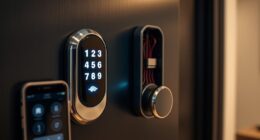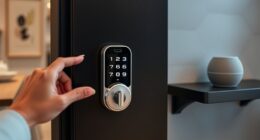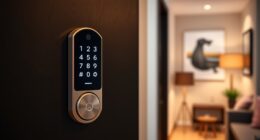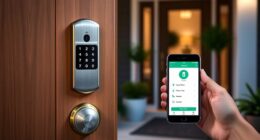The first home security system, invented by Marie Van Brittan Brown in 1966, changed how you protect your home. It featured four peepholes at various heights for visibility and a motorized video camera that streamed real-time images to a monitor in your house. You could communicate through two-way microphones, allowing conversations with visitors without opening the door. An emergency button also enabled quick alerts to police. This innovative design laid the foundation for modern security systems and emphasized a new approach to home safety. If you're curious about how these features impact today's technology, there's much more to uncover.
Key Takeaways
- The first home security system, invented by Marie Van Brittan Brown in 1966, utilized a motorized video camera to stream images to a television monitor.
- It featured four peepholes positioned at different heights, ensuring visibility for individuals of varying heights.
- Two-way microphones allowed homeowners to communicate with visitors without opening the door, enhancing safety.
- An emergency button enabled instant alerts to police or security services, improving response times during crises.
Historical Context of Invention
In the turbulent landscape of 1960s America, Marie Van Brittan Brown's invention emerged as a response to the escalating crime rates that plagued her Jamaica, Queens neighborhood.
With her community facing increasing threats, she recognized the need for a reliable way to safeguard homes. Driven by this urgency, Brown pioneered the first home security system in 1966, a groundbreaking development that would change how people approached safety.
Her innovative system featured four peepholes to accommodate different heights, allowing residents to see who was at their door.
A motorized video camera streamed images to a television monitor, giving homeowners a clear view of potential intruders.
Brown's design wasn't just about visibility; it included a two-way audio system for communication with visitors and an emergency alarm that could alert police via radio.
Marie Van Brittan Brown's Contributions

Marie Van Brittan Brown changed the game with her innovative security features in the first home security system.
Her groundbreaking patent not only recognized her contributions but also set the stage for modern security technology.
You can see how her work has had a lasting impact on society, making homes safer for everyone.
Innovative Security Features
Revolutionizing home security, Brown's system introduced features like real-time surveillance and two-way audio communication, setting a new standard for safety.
By incorporating a motorized video camera that could slide and provide immediate visuals, you could easily monitor who was at your door. The images projected onto a television monitor made it convenient to see visitors without stepping outside.
Brown's design also included four peepholes at varying heights, ensuring accessibility for everyone, regardless of their stature. This thoughtful feature enhanced the system's usability, making it more inclusive.
The two-way audio communication allowed you to converse with visitors through an external microphone and an internal speaker, so you didn't have to open the door to engage with anyone.
Additionally, the integration of an emergency alarm system, which could alert the police via radio, greatly improved the effectiveness of home security during crises.
By establishing a closed-circuit television (CCTV) setup, Brown laid the groundwork for modern home security systems, influencing countless innovations that followed.
Her contributions shaped how we think about and implement security in our homes today.
Patent and Recognition
Brown filed a groundbreaking patent for her home security system in 1966, which was granted three years later, marking a significant milestone in the field of safety and security. Her innovative design not only changed how people thought about home safety but also paved the way for modern security systems.
Here are four key contributions that evoke the importance of her work:
- Motorized Camera: Allowed homeowners to see visitors without opening the door, enhancing safety.
- Multiple Peepholes: Provided varied height visibility, ensuring accessibility for everyone.
- Two-Way Communication: Enabled interaction through an external microphone and internal speaker, creating a safer environment.
- Recognition: Her invention was acknowledged in a 1969 interview with The New York Times, highlighting its significance.
Despite limited commercial success during her lifetime, Brown's patent, U.S. Patent number 3,482,037, has been cited in 35 subsequent patents, showcasing its lasting influence.
Her contributions to the field of home security deserve recognition, as they laid the foundation for the advanced systems we rely on today.
Lasting Impact on Society
The first home security system not only transformed personal safety measures but also inspired countless innovators, particularly women and people of color, to pursue careers in technology and engineering.
Marie Van Brittan Brown's groundbreaking invention in 1966 introduced a motorized camera, providing real-time surveillance that was essential during a time of rising crime rates. Her system's innovative features, like four peepholes and two-way communication, enhanced safety for vulnerable populations, making a lasting impact on American history.
While her invention didn't achieve commercial success during her lifetime, it laid the groundwork for modern surveillance systems, which now dominate a $50 billion market in the U.S. Brown's patent, granted in 1969, has influenced over 35 subsequent patents, solidifying her role as a pioneer in home security technology.
Brown's contributions have resonated through generations, encouraging aspiring inventors to break barriers in tech fields. Her legacy emphasizes the importance of innovation in addressing societal safety concerns, showing that one person's idea can spark a movement and inspire future advancements.
Technical Features of the Original System

How did the original home security system combine innovative features to enhance safety and communication for homeowners? Invented by Marie Van Brittan Brown in 1966, this groundbreaking system utilized several key elements that set the foundation for modern home security. Brown’s original home security system included a closed-circuit television (CCTV) camera, a two-way microphone, and a remote-controlled door locking mechanism. These features allowed homeowners to see and communicate with visitors at their door from a safe distance, and even lock the door remotely if necessary. The integration of these components laid the groundwork for the development of modern home security systems, which now incorporate advanced technology such as motion sensors, mobile app connectivity, and 24/7 monitoring services to provide comprehensive protection for homeowners.
- Four peepholes: Positioned at different heights, these allowed you to see visitors from various angles, ensuring you never miss who's at the door.
- Motorized video camera: This device could slide to capture real-time images, projecting them onto an indoor television monitor for clear visibility of any potential threats.
- Two-way microphones: These enabled direct communication between you and anyone at your door, offering a sense of connection and control.
- Emergency button: An integrated feature that allowed you to alert police or security services instantly through a radio signal, providing peace of mind during emergencies.
Together, these components established a closed-circuit television (CCTV) system that revolutionized home security.
This innovative setup not only enhanced your safety but also transformed how you could communicate with the outside world, making homes safer than ever before.
Patent Process and Recognition

When you look at Marie Van Brittan Brown's patent journey, you see a fascinating blend of innovation and recognition.
Her application process not only garnered media attention but also paved the way for future inventions in home security.
Despite initial challenges, her work has left a lasting impact, influencing numerous patents that followed.
Patent Application Process
Applying for a patent involves traversing a complex process that can determine the recognition and protection of your invention. For instance, when Marie Van Brittan Brown filed her patent application for a home security system in 1966, she faced numerous challenges. Her innovative features, including a motorized camera and two-way communication, needed to be clearly defined.
Consider these key steps in the patent application process:
- Research: You must verify your idea is original and not already patented.
- Documentation: Prepare detailed descriptions and drawings that illustrate how your invention works.
- Submission: File your application with the U.S. Patent and Trademark Office, guaranteeing all guidelines are followed.
- Review: Be ready for an examination process that may involve answering questions and making adjustments.
Brown's patent was granted in 1969, marking a significant milestone in home security technology. Despite her groundbreaking contributions, she didn't receive the recognition or financial benefits she deserved.
Maneuvering the patent process is vital for inventors like you, as it can shape the future of your innovation and its impact on the market.
Recognition and Awards
Marie Van Brittan Brown's groundbreaking home security system not only gained a patent but also earned recognition from various prestigious organizations, underscoring its significance in the domain of technology and security.
After filing her patent in 1966 and receiving it in 1969 under U.S. Patent number 3,482,037, her invention quickly caught the attention of the media. A notable feature in The New York Times highlighted the innovative design and functionality of her system.
The National Scientists Committee recognized her work, presenting her with an award that celebrated her contributions to technology and security. This acknowledgment from a reputable organization signifies the impact her invention had on the field, showcasing that it wasn't just a novel idea but one that laid the groundwork for future advancements.
Despite the accolades, it's essential to recognize that Marie didn't reap financial benefits from her invention.
Nonetheless, her patent has been cited in 35 subsequent patents, illustrating her lasting influence on the evolution of surveillance technology. Her legacy continues to inspire innovators in security today, proving that groundbreaking ideas can come from anyone, regardless of recognition during their lifetime.
Impact on Future Patents
The impact of Marie Van Brittan Brown's patent extends far beyond its initial grant, influencing a wave of subsequent inventions in home security technology. Her innovative design introduced key features, like motorized cameras and two-way audio systems, that have become staples in modern security systems. This foundational work led to a significant ripple effect in the patent landscape.
Here are four ways her patent shaped the future of security technology:
- Inspiration for Innovation: Brown's system inspired inventors to explore new ideas, leading to advancements in surveillance.
- Cited in Over 35 Patents: Her original patent has been referenced in numerous subsequent patents, proving its lasting relevance.
- Media Recognition: Coverage by major outlets like The New York Times helped elevate awareness and respect for her contributions.
- Legacy in Today's Products: Contemporary security solutions, such as the Ring Doorbell, directly reflect principles from her design.
Ultimately, Marie Van Brittan Brown not only secured her place in history but also paved the way for future inventions in home security, demonstrating how one patent can transform an entire industry.
Early Uses and Impact

In 1966, the introduction of the first home security system revolutionized how homeowners interacted with their front doors, allowing them to see and communicate with visitors safely.
Invented by Marie Van Brittan Brown, this groundbreaking system featured a motorized camera that projected images onto an indoor television monitor. You could visually identify who was at your door before even opening it.
The design included four peepholes at different heights, making it accessible for everyone in your household. With the two-way communication feature, you could converse with visitors through an external microphone and internal speaker, enhancing your safety without the need to open the door. Plus, the emergency button allowed you to alert police or security services quickly in case of a threat.
Though production interest was limited at the time, the impact of Brown's invention on home security was significant. It laid the groundwork for future innovations, influencing the development of closed-circuit television (CCTV) systems we widely use today.
This early home security system not only improved personal safety but also set the stage for the advanced security technologies we rely on now.
Evolution of Home Security Technology

Building on the foundation laid by early innovations, home security technology has rapidly evolved to incorporate advanced features that enhance safety and convenience for homeowners. Today, modern home security systems offer a range of capabilities that were unimaginable just a few decades ago.
You can now enjoy benefits like:
- Real-time Monitoring: Keep an eye on your property from anywhere using smartphone apps.
- Smart Integrations: Connect your security system with smart devices for seamless operation.
- Enhanced Surveillance: Utilize high-definition IP cameras that provide crystal-clear images day or night.
- DIY Options: Take control of your home security with affordable, easy-to-install systems tailored to your needs.
This evolution means that home security isn't only more accessible but also more effective.
With features such as two-way audio, motion detection, and automatic alerts, you can respond to potential threats instantly.
As you embrace modern home security technology, you're not just protecting your home; you're enhancing your peace of mind, knowing that you're equipped with the best tools to safeguard your loved ones and valuables.
Market Growth and Trends

Market demand for home security solutions is skyrocketing, reflecting a growing awareness of safety and the desire for advanced technology in everyday life. The global home security market is projected to reach $78.9 billion by 2025, driven by increasing consumer demand and technological advancements.
You'll notice the rise of DIY security systems, making installations more affordable and allowing you to customize your solutions without needing professional help.
Subscription-based monitoring services are expanding, catering to those of you who want extra security for your homes. This trend shows how essential home security has become in today's society.
Plus, the proliferation of smart home technology means that security systems are now integrating seamlessly with IoT devices, enhancing interconnectivity and making your life easier.
However, keep in mind that geographical availability of home security services varies widely. Some areas still face limited access to security providers, but industry experts anticipate expansion as demand continues to grow.
With these trends, it's easier than ever to find a home security solution that fits your needs and budget, ensuring you feel safe and secure in your own space.
Legacy of the First System

The groundbreaking invention by Marie Van Brittan Brown not only set the stage for modern home security systems but also highlighted the importance of safety and innovation in everyday life. Her pioneering work has left a lasting legacy, influencing how we think about security in our homes. Today, when you install security cameras or smart home systems, you're building on the foundation she laid.
Here are some ways her invention resonates today:
- Enhanced Safety: Just like Brown's system, modern technology empowers you to monitor your home from anywhere.
- User-Friendly Design: The simplicity of her four peepholes reminds us that effective security doesn't have to be complicated.
- Two-Way Communication: This feature paved the way for video doorbells, allowing you to interact with visitors without opening the door.
- Inspiration for Diversity: Brown's legacy as a pioneering Black woman inventor encourages future innovators to pursue their ideas in technology.
Her contributions remind us that innovation often springs from necessity, and her influence continues to shape the home security market, projected to reach $78.9 billion by 2025.
Future of Home Security Systems

As technology continues to evolve, you'll soon find home security systems integrating smarter features that make protecting your space easier and more efficient.
The future of these systems hinges on advanced AI-driven solutions that enhance threat detection and response through machine learning algorithms. You'll enjoy real-time alerts and proactive monitoring, ensuring that your home is safer than ever.
Additionally, the integration of IoT devices will allow for seamless home automation. You'll be able to control security features remotely via your smartphone, giving you peace of mind wherever you are. Imagine locking your doors or viewing live camera feeds with a simple tap.
Biometric security measures, like facial recognition and fingerprint scanning, are on the rise, offering personalized access control tailored to your family's needs. As the home security market grows, affordability and DIY options will make these systems more accessible than ever.
However, with these advancements come the need for enhanced cybersecurity measures. Protecting your smart home devices from hacking and data breaches will be essential in maintaining your privacy and security in this increasingly connected world.
Frequently Asked Questions
How Did the First Security System Work?
You'll find the first security system worked by using a motorized camera that slid between peepholes. It allowed you to see visitors on a TV screen, communicate with them, and alert authorities if needed.
When Was the First Home Security System Installed?
Think of the first home security system as a watchful guardian. Installed in 1966, it marked a new era in home safety. You'd feel its protective presence, paving the way for modern security solutions.
How Did the First Burglar Alarm Work?
The first burglar alarm worked by completing an electromagnetic circuit when a door or window opened, triggering a bell. You'd hear the alarm ring, alerting you to potential intruders in your home.
What Is the Oldest Security System?
Ever wonder what kept homes safe in the past? The oldest security system dates back to 1853, when Augustus Russell Pope invented the first electromagnetic alarm, signaling danger with a loud, attention-grabbing sound.
Conclusion
As you imagine the first home security system, picture Marie Van Brittan Brown peering through her peephole, her heart racing at the thought of safety.
That humble invention sparked a revolution, transforming how we protect our homes.
Today, as you walk past your high-tech security cameras, think of the legacy built from Brown's ingenuity.
The future holds even more innovations, but it all started with one woman's vision, reminding us that true security begins at home.









